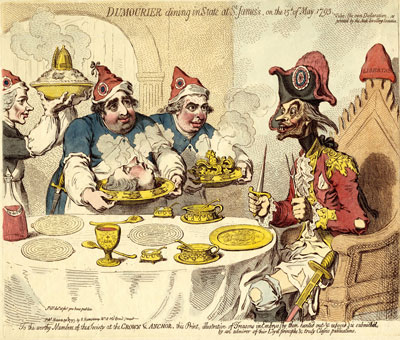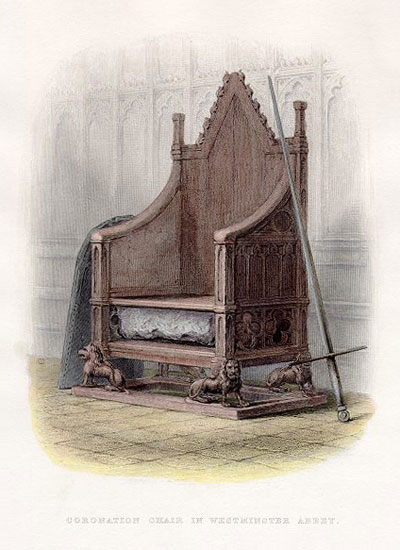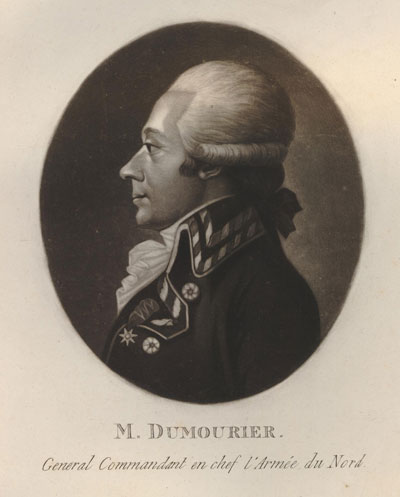Dumourier Dining in State at St James's, on the 15th of May, 1793.
Throughout his career, Gillray had a gift for imagining the worst, for portraying as already completed what was really only a dire possibility. In Patriotic Regeneration (1795), for instance, he showed the English House of Commons, re-named the British Convention, after it has been taken over by the French and Francophile Whigs, conducting a sham trial, like those of the French Reign of Terror. In New Morality (1798) he showed the President of the French Directory, M. Revelliere-Lepeaux, already installed at St Paul's Cathedral as the head of the new post-revolutionary religion of theophilanthropy. And in 1799, Gillray was engaged to produce a whole series of prints titled Consequences of a Succesful French Invasion, showing many imagined aspects of a post-revolutionary England.

© Trustees of the British Museum
Dumourier Dining in State at St James's, on the 15th of May 1793* is an early example of the same kind of dystopian vision. As the title suggests, this is a glimpse into the not-too-distant future, when (Gillray predicts) the French General Commandant in Chief of the Army of the North, Charles Francois Dumouriez, would be occupying the Royal Residence at St James's Palace in place of the King. He sits on what is clearly intended to recall the hereditary British Coronation Chair now with a revolutionary bonnet rouge at its peak, and the the Stone of Scone just visible at the bottom.

© Wikipedia
The tableware reflects the nationality of its new resident with its serving platters liberally decorated with French frogs, and the goblet in the foreground with its SIH (properly IHS) monogram alluding to French Catholicism.
The dinner fare is precisely suited to a French revolutionary palate, consisting of the head of the Tory Prime Minister William Pitt, a steaming (and collapsed) royal crown, and a shepherds pie topped with frogs and a mitre—all to be washed down with a bottle of "Vin de Paris." The attendants on this feast are Gillray's favorite Whig triumvirate: Charles James Fox (holding the platter with Pitt's head), Richard Brinsley Sheridan (offering the plate with the crown), and dissenting minister, Joseph Priestly, with the mitre-capped shepherd's pie. All of them wear bonnets rouges with tri-color cockades announcing their fealty to revolutionary France.
As the mezzotint below attests, Gillray's Dumourier is NOT a caricature portrait, of the French Commandant, but the logical extension of a national sterotype Gillray had been evolving for years. As far back as 1780 with National Discourse Gillray had been portraying Frenchmen with jutting jaws and emaciated profiles. But at that stage they were always foppish and fashionable. With the coming of the French Revolution, Frenchmen were still shown as thin with jutting jaws, but now identified as sans-culottes and portrayed literally without breeches as with the revolutionaries in Sans-Culottes Feeding Europe with the Bread of Liberty (1793) and the poor family in Un Petit Souper a la Parisienne. . . (1792).

©Trustees of the British Museum
In his portrait of Dumourier, Gillray still includes a bit of the dandy in the ruffled sleeves and neckcloth, but now Dumourier's clothes are tattered, and like all good sans-culottes he is without breeches. His emaciation, like that of the poor French family, is no longer fashionable but frightening, as he looks on the feast of Church and State proferred by the Francophile Whigs with a kind of mad anticipation.
Beneath the image is a somewhat puzzling caption:
To the worthy Members of the Society at the Crown & Anchor, this Print, illustrative of Treasons in Embryo, (by them hunted out & exposed,) is submitted, by an admirer of their Loyal principles & truly Classic publications.
The Crown and Anchor Society was another name for the Association for Preserving Liberty and Property against Republicans and Levellers. Founded by the ultra-conservative activist, John Reeves, in 1792, it was famous for disrupting what it deemed were radical meetings, attacking printers who published works that it considered seditious (such as Thomas Paine's The Rights of Man), and tracking down and prosecuting persons suspected of treason and sedition, broadly defined.
As this and many other prints attest, Gillray was no fan of Fox and his Whig compatriots. And as here, he routinely shows them performing actions which, if true, would certainly be treasonous. But as he demonstrated in Vices Overlook'd in the New Proclamation, and later in The Crown and Anchor Libel Burnt by the Public Hangman he was also critical of attempts by the King, Reeves, and his not so secret Tory supporters to muzzle the press and restrict Gilltray's own freedom to satirize whom and what he wanted. So the caption is equivocal, both serious and ironic. And it may suggest Gillray's own nervousness about how this print will be taken. For though Dumourier Dining in State is obviously critical of Whig representatives and values, it is also an implicit condemnation of the administration's handling of the war, predicting as it does the imminent (May 15) takeover of Britain by Dumourier and the French.
* One part of Gillray's "prediction" was almost immediately contradicted. Dumourier was defeated in a major battle at Neerwinden even while this print was being created. After trying unsuccessfully to convince his troops to march on Paris and bring down the revolutionary government, he then defected to Austria.
Sources and Reading
- Commentary from the British Museum on Dumourier Dining in State at St James's, on the 15th of May, 1793.
- Draper Hill, The Satirical Etchings of James Gillray, 1976 #30
- Crown and Anchor, Strand
- "Charles Francois Dumouriez," Wikipedia
- "Coronation Chair," Wikipedia
- "Association for Preserving Liberty and Property against Republicans and Levellers," Wikipedia
- "John Reeves (activist)," Wikipedia
- "title," Wikipedia
- "title," Wikipedia
- Thomas Wright and R.H. Evans, Historical and Descriptive Account of the Caricatures of James Gillray #101
Comments & Corrections
NOTE: Comments and/or corrections are always appreciated. To make that easier, I have included a form below that you can use. I promise never to share any of the info provided without your express permission.